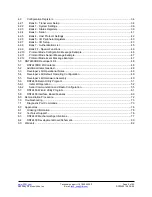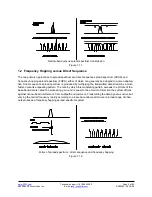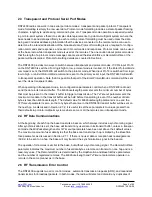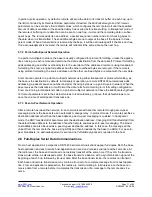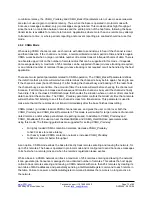
www.RFM.com
Technical s1.678.684.2000
Page 17 of 82
©2009 by RF Monolithics, Inc.
E-mail:
DNT2400 - 08/18/09
2.10.4 Latency
The worst case latency for TDMA access, excluding retries, occurs when the radio receives data just after
its turn to transmit. In this instance, it will have to wait the length of time set by the HopDuration to begin
transmitting the data. If the radio is receiving data over its serial port at a rate higher than its throughput,
this will only occur at the beginning of a transmission that spans several hops.
In a polling application, latency is affected by how long the remote and/or its host takes to respond, and
when in the hop data is ready to be transmitted. Since a remote can begin transmitting at practically any
time during the hop after the base has transmitted, the latency can be less than HopDuration. However,
the remote transmission may extend over two hops if it starts late in the first hop.
Latency for any given remote in a CSMA network is particularly difficult to characterize. If many remotes
have data to send, the latency for the last remote to send will be the length of time it takes all the other
remotes to send. The CSMA scheme used in the DNT2400 is designed to allow each remote an equal
opportunity to transmit, so the concern is not that one remote is locked out, but just how long it will take a
number of remotes with data to sent to each gain access to the channel and send their data. The more
data that needs to be sent, the more time will be consumed checking the channel and backing off when
the channel is busy. Again, this is why CSMA networks are best used when there are a large number of
nodes that send data infrequently.
The other factor impacting latency is retries. This impact is not unique to frequency hopping radios but is
common among all wireless technologies. A radio only transmits data once per hop. It needs to wait until
the next hop to see if the transmission was received at the destination. If not, the radio will transmit the
data again and wait for the acknowledgement. This can happen up to ARQAttemptLimit number of times
which is equal to ARQAttemptLimit times HopDuration amount of time.
2.10.5 Configuration Validation
Although slot durations are automatically calculated by the DNT2400, the RF data rate, hop duration, etc.,
must be coordinated by the user to assure a valid operating configuration based on the following criteria:
1. Regardless of the RF data rate, the maximum DNT2400 hop duration is limited to 200 ms. A
DNT2400 network must be configured accordingly.
2. In protocol mode, the BaseSlotSize and RemoteSlotSize parameters must be large enough to
hold all the data bytes in the largest protocol formatted message being used. Protocol formatted
messages must be sent in a single transmission. Any protocol formatted messages too large for
the slot size setting will be discarded
3. In TDMA mode 2, the RemoteSlotSize will be reduced automatically when a new remote joins the
network. This can cause a network to suddenly malfunction if the hop duration is not set to pro-
vide an adequately large remote slot allocation when fully loaded with remotes
4. When operating in polling mode 0, the CSMA_RemtSlotSize and HopDuration parameters are
usually set to accommodate the number of data bytes in a maximum size transmission. This con-
figuration provides low latency for polled messages.


